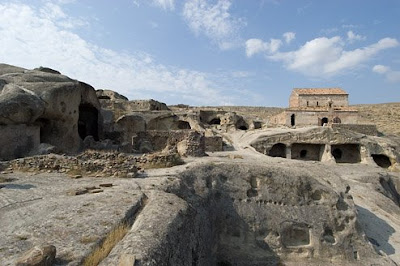 The name 'Uplistsikhe' (უფლისციხე) literally means 'the lord's fortress'; this ancient city on the Mtkvari River - complete with streets, churches, palaces, concert halls and living quarters - was carved out of the rock, beginning in the 5th century BC. Over the centuries, a unique combination of various architectural styles from Anatolia and Iran would emerge, with pagan and Christian structures eventually standing side by side.
The name 'Uplistsikhe' (უფლისციხე) literally means 'the lord's fortress'; this ancient city on the Mtkvari River - complete with streets, churches, palaces, concert halls and living quarters - was carved out of the rock, beginning in the 5th century BC. Over the centuries, a unique combination of various architectural styles from Anatolia and Iran would emerge, with pagan and Christian structures eventually standing side by side. Located just 10km east of modern-day Gori, Uplistsikhe is one of the oldest urban centers in Georgia and grew to be a key religious, political and cultural center in the Hellenistic period, in part due to its strategic location in the heartland of the Kingdom of Kartli (known as Iberia to the ancient writers).
Located just 10km east of modern-day Gori, Uplistsikhe is one of the oldest urban centers in Georgia and grew to be a key religious, political and cultural center in the Hellenistic period, in part due to its strategic location in the heartland of the Kingdom of Kartli (known as Iberia to the ancient writers). With the establishment of Christianity in Georgia in 337, the city's importance declined, with Mtskheta and later Tbilisi emerging as the centers of Christian culture. However, due to its ancient greatness, medieval Georgian writers ascribed its foundation to the mythical Uplos, son of Mtskhetos, and grandson of Kartlos.
 The city rose to prominence again in the 9th century and became a stronghold during the Muslim conquests, until Genghis Khan destroyed the city in 1240. By the 14th century it was deserted.
The city rose to prominence again in the 9th century and became a stronghold during the Muslim conquests, until Genghis Khan destroyed the city in 1240. By the 14th century it was deserted.Several of the most vulnerable parts of the ruins were completely destroyed by an earthquake in 1920. Stability remains a key concern, prompting the Fund of Cultural Heritage of Georgia (a joint project of the World Bank and Government of Georgia) to launch a conservation program in 2000. Of the original 700 caves, only about 150 remain, though they are well known for their breathtaking beauty.


No comments:
Post a Comment